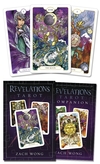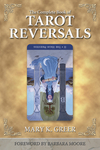New Ideas for Tarot Reading Variety

Need some variety?
There are a lot of ways to use tarot cards—for divination, for meditation, for problem-solving. If you've only used tarot for divination and are curious about these other applications, you must get Mark McElroy's What's in the Cards for You? Mark provides a month's worth of exercises that only take a few minutes a day. Do one each day and you'll not only get hands-on experience with these applications, you'll also find out which are best for you. At the end of the month, you tally up how effective you felt each day was, then, like a magazine quiz, you'll find out which application is most suited to your needs and preferences. In a similar vein of thought, Mark's The Bright Idea Deck presents methods of creative visualization for practical application in every day life. Following are a few examples of techniques for using this unconventional brainstorming tool.
- Explore new directions. Pick one card to represent what you already plan to do, then choose three cards to illustrate and suggest alternatives.
- Meditate. Select a card. Focus on it exclusively for ten minutes. Practice rebuilding every detail of it in your mind's eye. If thoughts drift, return gently to the card's image.
- Get to know someone better. Pick a card to represent someone; have that person pick a card that represents you. Discuss why you chose the cards you selected.
- Plan party themes. Draw cards at random, allowing the people, places and situations on each card to suggest decorations or activities for your party.
Need it all?
If you already use tarot for divination, or if you want to, then I'd say Teresa Michelsen's The Complete Tarot Reader is one of the best "learning the tarot" books available. Teresa doesn't just tell you how to read the cards, she actually teaches you how. Organized like a study guide, her book includes study goals, progress activities, and easy exercises for exploring the cards. As you advance and gain confidence, the book progresses to reading techniques, such as reversals, dignities, timing, and large spreads. Teresa explains underlying structures and patterns that make the tarot come alive with meaning. You will learn how the tarot relates to astrology, numerology, psychology, and mythology. Finally, you get help in dealing with difficult querents (whether they are clients or friends), reader's block, asking good questions, and ethical issues. The subtitle says it all: "Everything You Need to Know from Start to Finish!" Another great introduction to tarot study is What Tarot Can Do for You. Besides giving information on tarot applications in the fields of divination, problem solving, meditation, journaling, magic, and self-improvement, it also provides a quality overview of card meanings. Below is an outline for choosing a significator card in a spread.
A significator, traditionally, has been selected in one of four ways:
- Use the Magician to represent a male querent or The High Priestess to represent a female querent.
- Select a court card to represent the querent based on physical coloring and age, using the lists below.
- Select a court card based on astrological sign and age, using the lists below.
- Select a court card based on personality and age, using the categories and traits below.
Age
- Page: a child
- Knight: a young man
- Queen: a woman
- King: a mature man
Physical Appearance
Astrological Sign
Personality
Need something completely different?- Wands: a fiery, passionate, energetic person
- Cups: an emotional, creative person
- Swords: an intellectual, logical person
- Pentacles: a down-to-earth, practical person
Zach Wong's Revelations Tarot reveals another dimension of tarot. With so many decks on the market, it is rare that an idea is new, unique, beautiful, and truly practical. The question of reversals inspires endless debate amongst tarot readers. Do you use them? How do you read them? Zach has tackled that problem and solved it very creatively. His cards have both an upright and reversed image. His art is clever and beautifully done so that you get a sense of unity within extremes with each card. For example, here is The Star in both upright and reversed.The Star, representing hope and renewal in its upright position, is depicted with the woman facing forward unafraid of the future, light and doves filling the scene, as she freely gives to the universe.
The reversed image show someone who's turned her back on the future and has closed herself off from the universe. Her experience is much darker and formless than the upright version.
Zach has created a beautiful and useful deck.
Another Point of View
Speaking of reversals, did you know that we carry the premiere work on the subject? Mary Greer's The Complete Book of Tarot Reversals is indispensable to anyone who intends to read tarot. Whether or not you end up using them, you owe it to yourself and those you read for to be well-informed on this topic. Here's an excerpt to whet your appetite:"How do I read reversed cards?" "Why bother with reversals at all?" Answering these questions for students over the past thirty years led me to write this book.
For a time, I ignored reversals because I did not like the meaning I found in books. Then I found that the cards seem to work no matter what interpretations I used, as long as I specifically intended that the cards followed that system. It is the reader's decision whether or not to use reversals, as is the choice of what they are to signify.
Many readers find that reversals add depth, nuance, tone, and subordinate ideas to the upright meaning. When seeking unambiguous answers you can effectively double the possibilities. Furthermore, they encourage us to see things from a different and more complex point of view. Receiving too many reversals can make you feel like you have been dealt a "losing hand," but hopefully, this book will help turn that around.
In truth, reversals are ways to see through to the "other side." They allow us to go beyond the limits of the known. In offering further possibilities and insights that are not immediately apparent, they provide an opportunity to reach beyond logic and lead us into the realm of potentials and underlying causes where everything is connected and magic happens. We are invited to look beyond the obvious to a place of richer meaning. To assist in this process, try regarding reversed cards as if influenced by a divine Fool or Hanged Man. Reversals reveal the esoteric or hidden components, the shamanic perspective of the world, and a place known as the dream-time or inner planes versus so-called "reality."
Despite their rich potential, reversals are usually read in very limited or simplistic ways. You can characterize each card as good/bad, or use any other dualism. But, do not be misled by the fallacy that a reversal merely switches the good and bad attributes of the card—although it may sometimes do so. When seen primarily as negative, reversals needlessly emphasize the irrational fears and suspicions that gather around the creative gifts of the spirit and psyche. None of the cards are absolutely good or bad; each has meanings ranging from problematic to helpful. The Sun, for instance, can be happiness and joy or sunburn and burnout. When reversed, the Sun's effects are traditionally lessened rather than changed, so that the experience of either joy or burnout might be denied. However, the reversal can also tell you to look for the inner Sun and its spiritual guiding light rather than seeing it only as an external source.

About Barbara Moore
Related Products


is subject to certain Terms and Conditions